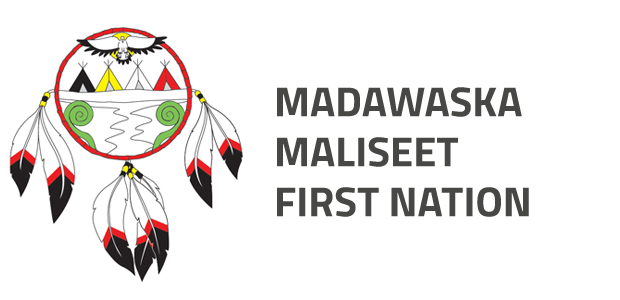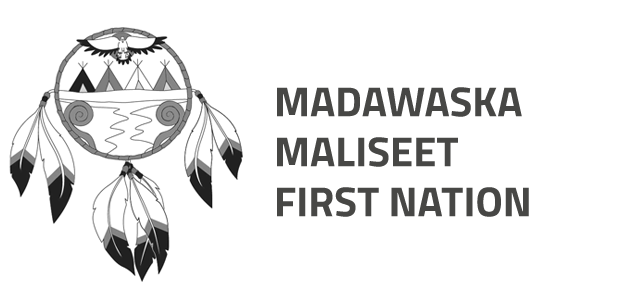Land Claim
and Community History
The Maliseet people (Wəlastəkwewiyik) have been here since time immemorial. Maliseet Territory consists of the St. John River watershed, extending from the St. Lawrence River to the Bay of Fundy.
1725/6 - 1792
1725/6
The Maliseet Nation (Wəlastəkwewiyik) and British Crown sign a Treaty of Peace and Friendship. This treaty begins a formal relationship between both parties.
1736
In 1689, nine-year old John Gyles was taken captive by Maliseets during King William’s War. He published a memoir of his experience in 1736 which mentions travelling through the Madawaska area. This first-hand account demonstrates how Maliseets utilized their entire territory. The Maliseet way of life requires people to move around to access resources and strategic locations at different times of the year.
1749
The Maliseet Nation (Wəlastəkwewiyik) and British Crown renew the 1725/6 Treaty.
1760
The Maliseet Nation (Wəlastəkwewiyik) and British Crown renew the treaties. These treaties do not cede any land and are nation-to-nation agreements establishing a continuous relationship.
1763
A Royal Proclamation is signed by King George III on October 7th, 1763 recognizing indigenous rights to land. It states that indigenous Nations must first cede land to the British Crown before being granted to settlers.
1765
The Maliseet Nation (Wəlastəkwewiyik) petitions the Governor of Quebec stating that settlers are hunting and encroaching on their lands and that the land between Grand Falls and Lake Temiscouata belongs to the Maliseet Nation (Wəlastəkwewiyik).
In the same year, a British map is drawn showing an Indian Village near the mouth of the Madawaska River.
In the same year, following the Treaty of Paris of 1763, large grants are made to English settlers on the lower St. John River (Wəlastəkw). This is a violation of the Royal Proclamation of 1763. Menahkwesk (at the mouth of the St. John River) and Ekwpahak, important Maliseet villages, are located in this area.
1778
A map is drawn of the St. John River (Wəlastəkw) showing an Indian Village at Madawaska (Matoweskok). It bears a Board of Ordnance stamp, making it an official military map.
[Carte de la rivière St. Jean] PANB, H1-203.29 [1765].
1779
Nova Scotia grants land to the Maliseet Nation (Wəlastəkwewiyik) at Ekwpahak (near present-day Fredericton, NB).
1783
Over 10,000 British Loyalists settle in the lower St. John River Valley and along the Bay of Fundy. This negatively impacts Maliseet rights to the land, way of life, and mobility. Ekwpahak and , an important Maliseet village, is located in this area.
1785
In the summer of 1785, the newly-formed province of New Brunswick government grants a License of Occupation to Acadian families, from lower St. John River (Wəlastəkw), for land near the Maliseet village at Madawaska (Matoweskok). A formal grant would not be issued until 1790. Although Acadians and Maliseets enjoyed a relatively amicable relationship, since the French Crown was more interested in trade, the establishment of permanent settlement reinforced by the British negatively impacts Maliseet rights and livelihood.
1787
In July and August, two survey plans of the St. John River (Wəlastəkw) are drawn by Surveyor-General George Sproule in July and August of 1787 - a “boundaries” survey and “communications” survey. He is guided along the river by Maliseets who provide detailed information about the land. On the boundaries survey, Sproule creates a reserve of 3,700 acres at Madawaska (Matoweskok) for the Maliseet Nation (Wəlastəkwewiyik).
George Sproule. “Un arpentage des grandes chutes de la rivière St. Jean à la tête du lac to the head of Lake Tamasquatat avec une partie du portage conduisant de ce lac au fleuve St. Lawrent.” [1787] LAC, MIKAN 4125554.
1788
On January 25th, Laurent Doucet petitions the Governor General in Quebec, for land at Madawaska (Matoweskok). Hugh Finlay, who met with George Sproule at Madawaska five months earlier, is on the committee that reviews Doucet’s petition. He states that the land Doucet is requesting may encroach on the land set aside for the Maliseet.
1790
On December 12th, Joseph Mazerolle and Others receive a grant at Madawaska (Matoweskok). The accompanying grant plan acknowledges the Indian Reserve; with the word “Indian” crossed out. The reserve is greatly reduced on a tracing of this plan, drawn at a later date. drawn at a later date, greatly reduces the size of the reserve.
Plan attaché à la subvention de 1790 à “Joseph Mazerolle & 48 autres”. George Sproule [1790] PANB, MC1236.
1792
Two years after the Acadians receive their grant, the Maliseet Nation (Wəlastəkwewiyik) sends a petition to New Brunswick requesting a grant for the reserve at Madawaska (Matoweskok).
On October 25th, the Maliseet Nation (Wəlastəkwewiyik) receives a grant from the New Brunswick government for the land at Ekwpahak.
On December 4th, Isaac Hedden completes a survey of the St. John River (Wəlastəkw) indicating a Maliseet village at Madawaska (Matoweskok).
1819 - 1861
1819-1823
During his time as Surveyor General, Anthony Lockwood, was removed from office due to insanity. His replacement, George Shore, notes that numerous documents are either destroyed or missing from the Crown Lands Office. It is possible that Lockwood had destroyed documents that would give more insight about the land at Madawaska.
1820
Joseph Treat is instructed by the Governor of Maine to travel to the upper St. John River (Wəlastəkw) to report on the settlement in that area and the quality of soil and forests. He mentions a land right that Maliseets have at Madawaska (Matoweskok).
1824
On March 4th, Simon Hebert petitions New Brunswick for a grant of 300 acres at the mouth of the Madawaska River. The accompanying sketch reveals that the land he is requesting is located on the Indian Reserve. Hebert states that he had “purchased the land from the Indians”. This is a violation of the Royal Proclamation of 1763.
On September 18th, Joseph Martin petitions New Brunswick for a grant of 400 acres at Madawaska (Matoweskok). On the back of the petition Surveyor-General Thomas Baillie writes, “The situation herein described is within the bounds of a Tract reserved for the Madawaska Indians, and is ungranted Land.”
1825
Francis Rice petitions New Brunswick for a grant of 200 acres at Madawaska (Matoweskok) and states it is located “above the Madawaska River and joining the Indian Reserve.”
On May 16th, Simon Hebert is granted 250 acres on the Indian Reserve at Madawaska (Matoweskok).
1828
Charles Davies publishes a report for the State of Maine about conflict between settlers from Maine and New Brunswick on the upper St. John River (Wəlastəkw), and recognizes that the Maliseet hold a land interest at the mouth of the Madawaska River.
1829
Simon Hebert receives a License of Occupation for land on the west side of the Madawaska River. Hebert was an inn keeper and benefited from travellers who stopped along the communication road.
1831
John G. Deane and Edward Kavanagh are instructed by the Governor of Maine to travel to the Madawaska Settlement and report on titles claimed by the settlers. They mention that five or six Maliseet families are living at Madawaska (Matoweskok) at the time.
1838
New Brunswick begins to inquire about the number and extent of Indian Reserves in New Brunswick. Surveyor-General Thomas Baillie publishes a “Schedule of Indian Reserves in New Brunswick”, but does not include the reserve at Madawaska (Matoweskok).
1841
Moses Perley is hired as New Brunswick’s first Indian Commissioner and is tasked with visiting Indian Reserves throughout the province. In his report, Perley discusses the problem with settlers squatting on Indian Reserves and describes a conversation with Chief Louis Bernard at Madawaska (Matoweskok).
1842
As a result of Perley’s Report After Perley publishes his report, another “Schedule of Reserved Indian Lands” is released, which includes the Madawaska Reserve as containing 700 acres. This is similar in size to the reserve drawn on the tracing of the Mazerolle Grant Plan, reduced from 3,700 acres set aside by George Sproule in 1787. Simon Hebert’s grant is mentioned on this schedule and his lot becomes the new boundary line of the reserve.
1843
The Grand Chief and leaders of the Maliseet Nation (Wəlastəkwewiyik) send a petition to the New Brunswick government about settlers trespassing on their land and request a single grant for all their reserves on the St. John River (Wəlastəkw).
1844
A provincial act is passed that would allow New Brunswick to sell off large portions of Indian Reserves. Although the act was not fully implemented, it reveals the government’s intentions toward Indian Reserves.
1845
HM Garden creates a survey dividing the Madawaska reserve into eight lots. Two of these lots are intended for Maliseet families.
H.M. Garden, “Dessin d’un arpentage de huit lots…” LAC Map Collection, H3/203.15.
1853
On February 12th, John Hartt petitions New Brunswick for a grant of land on the Madawaska reserve. Hartt had squatted on the reserve since at least 1842.
On April 23, Indian Agent, John Emmerson, writes a letter to the Surveyor General stating that Chief Louis Bernard and the Maliseets at Madawaska (Matoweskok) refuse to give land to John Hartt nor dispose of any part of the reserve.
1860
On April 1st, John Hartt is granted 100 acres on the Madawaska reserve.
In November, Surveyor Charles Beckwith creates a survey plan of the Madawaska reserve with eight lots and a back-boundary line that matches Hebert’s boundary line. John Hartt is granted lot 1 and Maliseet families are identified on three of the lots.
Subvention à John Hartt. PANB, Subventions des terres de la division des Ressources naturelles #9548 [F16357].
1861
On July 1st, at the age of 90, Chief Louis Bernard travels to Fredericton to petition the New Brunswick government against the sale of the Madawaska reserve and injustices he witnessed throughout his lifetime.
1907 - 2017
1907
In 1907, The Canadian Pacific Railway purchases 7.88 acres of the Madawaska reserve for the construction of a railroad. In 1988, the Madawaska Maliseet First Nation filed a claim against the Government of Canada. The claim was settled in 2008 with $5.7 million being awarded to the Madawaska Maliseet First Nation and returning the 7.88 acres to the reserve.
1956
Although, there have always been Maliseet leaders at Madawaska (Matoweskok), the first Chief and Council was formed under the Indian Act in 1956.
2017
In 1998, A specific claim was filed against the Government of Canada for the land that had been granted within George Sproule’s red-lined tract. On November 28, 2017, the Specific Claims Tribunal released a decision in favour of the Madawaska Maliseet First Nation. It stated that Sproule had created an Indian Reserve at Madawaska (Matoweskok) in 1787 and that the Crown had breached its fiduciary duty to protect this reserve for the Madawaska Maliseet.
© 2025 Madawaska Maliseet First Nation. All rights reserved. Design by Productions Rouj. Production by T-Nours Communications.

